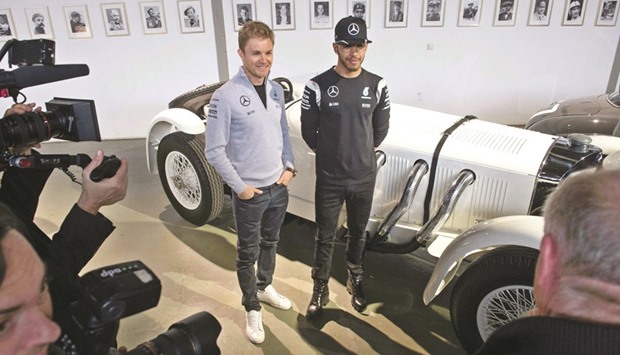More races, more teams, a trio of rookies and more complicated new rules, Formula One roars back to life with a fresh coat of paint in Melbourne next weekend, but facing many familiar problems and questions.
First among them is the unknown level of motivation that defending three-time world champion Lewis Hamilton will take into the 2016 season as he seeks a hat-trick of successive title triumphs with the all-conquering Mercedes team.
Hamilton, champion in 2008, 2014 and 2015, appeared to lose his ‘mojo’ at the end of last year once he had clinched the title with three races to go and that allowed his teammate Nico Rosberg to seize the momentum going into the European winter.
Pre-season testing in Spain has given few clues on how the Briton and the German will size up when they race in earnest for the first time at the season-opening Australian Grand Prix on March 20 and, beyond that, it is virtually impossible what may lie ahead.
While Mercedes delivered impressive reliability and endurance, as well as solid speed and performance, at the two weeks of testing in Spain, Ferrari were faster with both four-time champion Sebastian Vettel and his team-mate Kimi Raikkonen topping the times.
That suggests much of the same this year with Ferrari closing the gap and Vettel, in his second season with the scarlet scuderia, mounting a more serious challenge to the pace-setting Mercedes outfit.
For the champions, the main problem may be in managing the relationship between their globe-trotting superstar champion, who may be distracted, and his frustrated, but wholly committed, team-mate as Ferrari close in.
Behind them, the unchanged Williams and Red Bull teams are likely leaders of the chasing pack while the field will welcome the arrival of the new Haas team, the first American outfit to race in F1 in three decades.
With Dallara chassis and Ferrari power-units, and with Frenchman Romain Grosjean as lead driver alongside Mexican Esteban Gutierrez, they are aiming to make a solid mid-field start and may upset the returning Renault squad, following their take-over of Lotus.
It will also be intriguing to see if the McLaren-Honda team, which experienced a deeply disappointing 2015 season, continues to struggle—a story that could lead to tensions as two-time champion Fernando Alonso and the 2009 champion Jenson Button lose patience.
Renault’s return has ushered in team changes including the departure of Grosjean and the arrival of British newcomer Jolyon Palmer while Venezuelan Pastor Maldonado has been replaced by Dane Kevin Magnussen.
Renault’s return also means that their engines continue to be used though in 2016 with the aid of performance tweaking from Ilmor Engineering.
For Red Bull, the power units are being badged by Tag-Heuer while their ‘siblings’ Toro Rosso, with an unchanged driver line-up, have switched from Renault to Ferrari power.
The other two rookies will be the Manor Racing pairing of German prodigy Pascal Wehrlein and Indonesia’s first F1 driver Rio Haryanto in a Mercedes-powered team that is intent on making serious progress from the back.
Following the departures of team bosses John Booth and Graeme Lowdon, Manor have recruited former McLaren manager Dave Ryan and former Ferrari technical staff Pat Fry and Nikolas Tombazis. Haryanto, backed by significant Indonesian sponsorship, has captured his country’s imagination already and will further establish F1 in south-eastern Asia.
The calendar has expanded to an unprecedented 21 events, including a first visit to a new street circuit at Baku in Azerbaijan where the European Grand Prix will be held in June.
This event and the return of the German Grand Prix have been added to last year’s 19 races to create a demanding schedule.
While this will exhaust many people involved, it has given F1’s ‘sports tourist fans’ a wider range of races to choose from in a season that will see a range of minor technical changes.
Alterations to the exhaust systems are expected to make the engines sound louder—after widespread complaints orchestrated by the sport’s commercial supremo Bernie Ecclestone—and new tyre rules have given the teams a wider choice of Pirelli rubber.
This allows for three dry compounds for each driver, instead of two, and will usher in more variations in strategy, tactics and pit-stops. A new ‘ultrasoft’ tyre for street tracks is also being introduced.
Qualifying sessions are also changing with the use of an elimination system that will see a driver knocked out every 90 seconds in each of the three qualifying segments, Q1, Q2 and Q3.
It guarantees that only two cars will be left on track in the final minutes of Q3 -- and that the front row of the grid is decided when the chequered flag drops and not in the minutes afterwards as in previous years.
Like many other changes, it is cosmetic and will not hide a likely ongoing debate within the sport about its future shape and structure.

Mercedes drivers Nico Rosberg (left) and Lewis Hamilton pose in front of a Mercedes-Benz oldtimer racing car during a press conference in Fellbach, Germany, on Friday. (AFP)


